Poole: Difference between revisions
| Line 109: | Line 109: | ||
*{{Cite book|last=Legg|first=Rodney |title=The Book of Poole Harbour and Town|year=2005|publisher=Halsgrove|isbn=1-84114-411-8|postscript=<!--None-->}} | *{{Cite book|last=Legg|first=Rodney |title=The Book of Poole Harbour and Town|year=2005|publisher=Halsgrove|isbn=1-84114-411-8|postscript=<!--None-->}} | ||
*{{Cite book| last=Sydenham |first=John |title=The History of the Town and County of Poole |publisher=Poole Historical Trust| location=Poole |year=1986 |origyear=1839 |isbn=0950491446 |edition=2nd| postscript=<!--None--> }} | *{{Cite book| last=Sydenham |first=John |title=The History of the Town and County of Poole |publisher=Poole Historical Trust| location=Poole |year=1986 |origyear=1839 |isbn=0950491446 |edition=2nd| postscript=<!--None--> }} | ||
[[Category:Ports in Dorset]] | [[Category:Ports of Dorset]] [[Category:Seaside resorts in Dorset]] | ||
Revision as of 18:07, 2 April 2012
| Poole | |
| Dorset | |
|---|---|
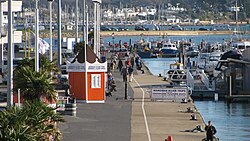 Poole Quay | |
| Location | |
| Grid reference: | SZ009906 |
| Location: | 50°42’56"N, 1°59’16"W |
| Data | |
| Population: | 138,800 (2001) |
| Postcode: | BH |
| Dialling code: | 01202 |
| Local Government | |
| Council: | Bournemouth, Christchurch and Poole |
| Parliamentary constituency: |
Poole Mid Dorset & North Poole |
Poole is a large coastal town and seaport in Dorset. The town is 20 miles east of Dorchester and its urban spread abuts that of Bournemouth in Hampshire to the east. It owes its position and prosperity to Poole Harbour, a vast and almost enclosed natural harbour able to provide shelter to many large ships and which is also blessed by a scattering of attractive islands.
The earliest recorded use of the town's name was in the 12th century when the town began to emerge as an important port, prospering from the wool trade. In later centuries the town had important trade links with North America and at its peak in the 18th century it was one of the busiest ports in Britain. During the Second World War the town was one of the main departing points for the D-Day landings of the Normandy Invasion.
Poole is both a working port town and a tourist resort, attracting visitors to the harbour, its history and its beaches. The town has a busy commercial port with cross-Channel freight and passenger ferry services. The Royal National Lifeboat Institution has its headquarters in Poole, and the Royal Marines have a base in the harbour.
Geography
Poole is stands on the northern and eastern edges of Poole Harbour, which opens into the English Channel. The oldest part of the town (including the historic Old Town, Poole Quay and the Dolphin Shopping Centre) lies to the south-east of Holes Bay on a peninsula jutting into the harbour, although much of the land to the east of the peninsula has been reclaimed from the harbour since the mid 20th century. To the west lie Upton and Corfe Mullen and across the northern edge of the town at the River Stour lies Wimborne Minster. South of Poole along the coast lies Poole Bay, with 3 miles of sandy beaches from Sandbanks in the west out to Bournemouth in the east.
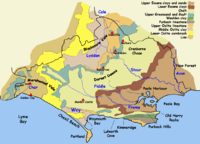
The natural environment of Poole is characterised by lowland heathland to the north and wooded chines and coastline to the south. The heathland habitat supports the six native British reptile species and provides a home for a range of dragonflies and rare birds. Development has destroyed much of the heath but scattered fragments remain to the north of Poole and have been designated Special Protection Areas.
The town lies on unresistant Tertiary beds of Eocene clays (mainly London Clay and Gault Clay), sands and gravels.[1] The River Frome runs through this weak rock, and its many tributaries have carved out a wide estuary. At the mouth of the estuary sand spits have been deposited, enclosing the estuary to create Poole Harbour.[2]
The harbour is the largest natural harbour in Europe and indeed the largest natural harbour in the world after Sydney Harbour.[3] It is an area of international importance for nature conservation and is noted for its ecology, supporting salt marshes, mudflats and an internationally important habitat for several species of migrating bird. It has been designated a Site of Special Scientific Interest (SSSI), a Special Protection Area and a Ramsar site as well as falling within an Area of Outstanding Natural Beauty.[4] The harbour covers an area of 15 square miles and is extremely shallow: although the main shipping channels are 25 feet deep the average depth of the harbour is 19 inches.[5][6]
Poole Harbour contains several small islands, of which the largest is Brownsea Island, a nature reserve owned by the National Trust for Places of Historic Interest or Natural Beauty|National Trust. Brownsea Island was the birthplace of the Scouting movement and location of the first Scout Camp.[7] Britain's largest onshore oil field operates from Wytch Farm on the south shore of the harbour.[8] The oil reservoirs extend under the harbour and eastwards from Sandbanks and Studland for 6 miles under the sea to the south of Bournemouth.[9]
Situated directly to the east of the Jurassic Coast, Poole is a gateway town to the UNESCO World Heritage Site, which includes 96 miles of the Dorset and east Devon coast important for its geology, landforms and rich fossil record. The South West Coast Path stretches for 634 miles from Minehead in Somerset, along the coast of Devon and Cornwall and on to Poole. The path is the United Kingdom's longest national trail.[10]

Churches
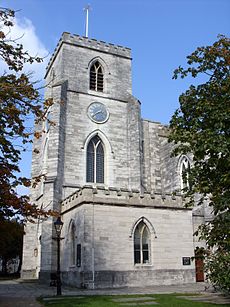
Poole falls within the Diocese of Salisbury
- Church of England:
- United Reformed Church: Also in the town centre, also Grade II* listed, built in 1777
- Romanian Orthodox: St. Osmund's (in Parkstone), a Byzantine-style church, formerly Church of England, becoming Romanian Orthodox in 2005
Ferry
Poole is a cross-Channel port for passengers and freight with up to seven sailings a day in the summer season. Ferry services from Poole Harbour to Cherbourg are provided by Brittany Ferries who operate two ferries from Poole: the 'Normandie Vitesse and the Cotentin. The Normandie Vitesse provides a high-speed daily passenger service to Cherbourg between May and September; the Cotentin freight ship covers the Poole-Cherbourg route year-round and runs a weekend service between Poole and Santander in Spain.[13][14] The Condor Ferries catamarans [Condor Express and Condor Vitesse run seasonal services to Guernsey, Jersey and St Malo in Brittany.[15]
History
The town's name derives either from the Old Welsh bol or pwll or the Old English word pol, both meaning "pool" or "creek".[16]
The Romans landed at Poole during their invasion of Britain in the 1st century and took over an Iron Age settlement at Hamworthy, an area just west of the modern town centre.[17]
In Anglo-Saxon days, Poole was a base for fishing and the harbour a place for ships to anchor on their way to the River Frome and Wareham, a very important town in that age.[18] Poole experienced two large-scale Viking invasions during this era: in 876, Guthrum the Dane sailed his fleet through the harbour to attack Wareham, and in 1015, Canute began his conquest of England in Poole Harbour, using it as a base to raid and pillage Wessex.[19][20]
Following the Norman conquest, Poole rapidly grew into a busy port as the importance of Wareham declined.[21] The town was part of the manor of Canford, but does not exist as an identifiable entry in the Domesday Book.[22] The earliest written mention of Poole occurred on a document from 1196 describing the newly built St James's Chapel in "La Pole".[23] The Lord of the Manor, Sir William Longspée, sold a charter of liberties to the burgesses of Poole in 1248 to raise funds for his participation in the Seventh Crusade,[18] which gave Poole a measure of freedom from feudal rule, and the right to appoint a mayor and hold a court within town. Poole's growing importance was recognised in 1433 when it was awarded staple port status by King Henry VI, permitting the export of wool through the port, and in due course the town obtained a licence to build a town wall.[24] In 1568, Poole was made a county corporate by a Charter of Elizabeth I.[25]
During the English Civil War, Poole's puritan stance and its merchants' opposition to the ship money tax introduced by King Charles I led to the town declaring for Parliament.[26] Poole escaped any large-scale attack and with the Royalists on the brink of defeat in 1646, the Parliamentary garrison from Poole laid siege to and captured the nearby Royalist stronghold at Corfe Castle.[27][28]
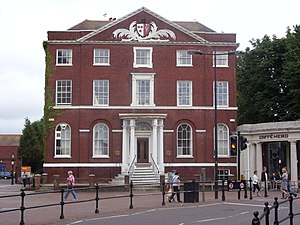
In the 16th century Poole established successful commerce with the British colonies in North America, including the important fisheries of Newfoundland.[25] The trade with Newfoundland grew steadily to meet the demand for fish from the Roman Catholic countries of Europe. Poole's share of this trade varied but the most prosperous period started in the early 18th century and lasted until the early 19th century. By the early 18th century Poole had more ships trading with North America than any other English port and vast wealth was brought to Poole's merchants.[29] This prosperity supported much of the development which now characterises the Old Town where many of the mediæval buildings were replaced with Georgian mansions and terraced housing.[30]
The end of the Napoleonic Wars and the conclusion of the War of 1812 ended Britain's monopoly over the Newfoundland fisheries and other nations took over services provided by Poole's merchants at a lower cost. Poole's Newfoundland trade rapidly declined and within a decade most merchants had ceased trading.[31][32]
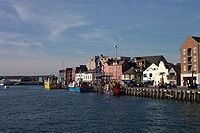
The town grew rapidly during the industrial revolution as urbanisation took place and the town became an area of mercantile prosperity and overcrowded poverty. At the turn of the 19th century, nine out of ten workers were engaged in harbour activities, but as the century progressed ships became too large for the shallow harbour and the port lost business to the deep water ports at Liverpool, Southampton and Plymouth.[29] Poole's first railway station opened in Hamworthy in 1847 and later extended to the centre of Poole in 1872, effectively ending the port's busy coastal shipping trade.[32] The beaches and landscape of southern Dorset and south-west Hampshire began to attract tourists during the 19th century and the villages to the east of Poole began to grow and merge until the seaside resort of Bournemouth emerged. Although Poole did not become a resort like many of its neighbours, it continued to prosper as the rapid expansion of Bournemouth created a large demand for goods manufactured in Poole.[33]
During Second World War, Poole was the third largest embarkation point for D-Day landings of Operation Overlord and afterwards served as a base for supplies to the allied forces in Europe.[25] Eighty-one landing craft containing American troops from the 29th Infantry Division and the US Army Rangers departed Poole Harbour for Omaha Beach.[34] Poole was also an important centre for the development of Combined Operations and the base for a US Coast Guard rescue flotilla of 60 cutters.[35]
Much of the town suffered from German bombing during the war and years of neglect in the post-war economic decline. Major redevelopment projects began in the 1950s and 1960s and large areas of slum properties were demolished and replaced with modern public housing and facilities. Many of Poole's historic buildings were demolished during this period, particularly in the Old Town area of Poole. Consequently, a Conservation Area was created in the town centre in 1975 to preserve Poole's most notable buildings.[36][37]
Economy
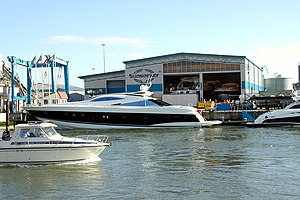
In the 1960s, Poole's economy was fuelled by growth in the manufacturing sector, but the 1980s and 1990s saw expansion in the service sector as office based employers relocated to the area. The importance of manufacturing has declined since the 1960s but still employed approximately 17% of the workforce in 2002 and remains more prominent than in the economy of Great Britain as a whole. Sunseeker, the world's largest privately-owned builder of luxury motor yachts, is based in Poole and employs over 1,800 people in its Poole shipyards.[38] It was estimated in 2004 that Sunseeker generates £160 million for the local economy.[39] Manufacturing remains strong, and several manufacturers are large employers in Poole
Tourism is also important to the Poole's economy and was worth an estimated £158 million in 2002. Hotels, guest houses and bed and breakfast rooms are found around the town, particularly in Sandbanks and the town centre.
Since the 1970s, Poole has become one of Britain's busiest ports. [40] Investment in new port facilities in Hamworthy, and the deepening of shipping channels allowed considerable growth in cross-channel freight and passenger traffic. The port is a destination for bulk cargo imports such as steel, timber, bricks, fertiliser, grain, aggregates and palletised traffic. Export cargoes include clay, sand, fragmented steel and grain.[4] Commercial ferry operators run regular passenger and freight services from Poole to Cherbourg, St Malo and the Channel Islands.
In 2008, 105 fishing boats were registered and licensed to the port and held a permit issued by the Southern Sea Fisheries District Committee (SSFDC) to fish commercially.[41] It is the largest port in terms of licences in the SSFDC district which covers the coastline of Dorset and Hampshire.
Landmarks
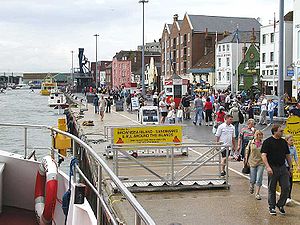
Poole Quay to the south of the town centre is lined with a mixture of traditional public houses, redeveloped warehouses, modern apartment blocks and historic listed buildings. Once the busy centre of Poole's maritime industry, all port activities moved to Hamworthy in the 1970s as the Quay became increasingly popular with tourists. The Grade II* listed Customs House on the quay-front was built in 1814 and now functions as a restaurant and bar.[42] Nearby the Grade I listed Town Cellars, a mediæval warehouse built in the 15th century on the foundations of a 14th century stone building, houses a local history centre.[43] Scaplen's Court, another Grade I listed building, also dates from the mediæval era.[44]
Poole's Guildhall has played a varied part in the history of the town. A Grade II* listed building, the Guildhall was built in 1761 at a cost of £2,250.[45][46] The new building included an open market house on the ground floor and a courtroom and offices for the town council on the first floor and has also been used as a Court of Record, Magistrates' Court, Court of Admiralty and a venue for Quarter Sessions. Between 1819 and 1821 the building was consecrated as a Parish Church while the old St James Church was pulled down and replaced with the present church.[45] During the Second World War the building was used as a canteen and meeting room for American soldiers before the invasion of France. The building was converted for use as the town museum between 1971 and 1991 but stood empty for the next 16 years until a renovation project. The Guildhall opened in June 2007 as a Register Office.[47]
Poole's sandy beaches are a popular tourist destination extending 3 miles along Poole Bay from the Sandbanks peninsular to Branksome Dene Chine at the border with Bournemouth.[48][49] The beaches are divided into four areas: Sandbanks, Shore Road, Canford Cliffs Chine and Branksome Chine. Along the seafront there are seaside cafés, restaurants, beach huts and numerous water-sports facilities.
Culture
The 'Beating of the Bounds' is an ancient annual custom first carried out in 1612, which revives the traditional checking of the sea boundaries awarded to Poole by the Cinque Port of Winchelsea in 1364.[50][51] The Admiral of the Port of Poole (the mayor) and other dignitaries, and members of the public sail from the mouth of the River Frome to Old Harry Rocks to confirm the Mayor's authority over the water boundaries of the harbour and check for any encroachments.
The Animal Windfest is an annual three day long festival of water-sports held at Sandbanks. The event features the UK windsurfing freestyle final, the second round of the British kiteboarding championships and other amateur competitions and demonstration events. First held in 1998, the festival attracts approximately 10,000 people each year.[52] Poole's Summertime in the South is an annual programme providing various events on Poole Quay and Sandbanks from May until September. During June and July, live music, street entertainment and a large firework display take place on Poole Quay every Thursday evening. In August, the entertainment moves to the beaches at Sandbanks.[53]
Poole's Lighthouse is the largest arts centre complex in the United Kingdom outside London.[54] Built in 1978, the centre contains a cinema, concert hall, studio, theatre, image lab and media suite and galleries featuring exhibitions of contemporary photography and modern digital art. The venue underwent an £8.5 million refurbishment in 2002, paid for by the Arts Council England, the Borough of Poole and private donations. The centre's concert hall has been the residence of the Bournemouth Symphony Orchestra's main concert series since their former base at the Bournemouth Winter Gardens closed in 1985, forcing them across the county boundary into Dorset.[55] Situated in the centre of the Old Town, Poole Museum illustrates the story of the area and its people and the collections reflect the cultural, social and industrial history of Poole. Displays include the Poole Logboat and a detailed history of Poole from the Iron Age to the present day. The museum has a floor devoted to the history of Poole Pottery and some of the company's products are on display. Entrance to the museum is free.[56]
References and notes
- ↑ "Geology of the Central South Coast of England". University of Southampton. 2006. http://www.soton.ac.uk/~imw/Field-Guides-Introduction.htm. Retrieved 2007-08-14.
- ↑ "Sandbanks Sand Spit". School of Ocean and Earth Science, University of Southampton. http://www.soton.ac.uk/~imw/Sandbanks.htm. Retrieved 2008-08-05.
- ↑ "Harbour". Borough of Poole. 2008. http://www.boroughofpoole.com/environmental/services/ref:S4651BE26C4E36/aka:Harbour/. Retrieved 2008-06-30.
- ↑ 4.0 4.1 "Poole Harbour Aquatic Management Plan 2006" (PDF). EcoPorts. 2006. http://www.ecoports.com/ContentFiles/poole%20harbour%20aquatic%20management%20plan%202006.pdf. Retrieved 2008-06-03.
- ↑ "The Dredging Operation". PooleBay.net. 2008. http://www.poolebay.net/PhaseI/dredging.htm. Retrieved 2008-06-03.
- ↑ "Rivers Piddle and Frome, and Poole Harbour" (pdf). Centre for Environment, Fisheries and Aquaculture Science. 2008. http://www.diadfish.org/maj2006_fichiers/maj_11_06_slime/piddle_and_frome.pdf. Retrieved 2008-06-30.
- ↑ Woolgar, Brian; La Riviere, Sheila (2002). Why Brownsea? The Beginnings of Scouting. Brownsea Island Scout and Guide Management Committee (re-issue 2007, Wimborne Minster: Minster Press).
- ↑ "BP Asset Portfolio: Wytch Farm" (PDF). BP plc. http://www.bp.com/liveassets/bp_internet/globalbp/STAGING/global_assets/downloads/U/uk_asset_wytch_farm.pdf. Retrieved 2008-06-27.
- ↑ Andrews I.J. & Balson P.S. (1995), Wight: Sheet 50N 02W Solid Geology, 1:250,000 Geological map series, Keyworth: British Geological Survey.
- ↑ "Distance Calculator". South West Coast Path Association. 2006. http://www.southwestcoastpath.com/main/walks_content/distancecalculator.cfm. Retrieved 2007-12-13.
- ↑ "Listed buildings online: Church Of St James". English Heritage. 2008. http://www.heritagegateway.org.uk/Gateway/Results_Single.aspx?uid=412453&resourceID=5. Retrieved 2008-08-24.
- ↑ "Listed buildings online: Church Of St Aldhelm". English Heritage. 2008. http://www.heritagegateway.org.uk/Gateway/Results_Single.aspx?uid=412582&resourceID=5. Retrieved 2008-08-24.
- ↑ "Poole to Cherbourg Route Details". Brittany Ferries. 2008. http://www.brittany-ferries.co.uk/routes/poole-cherbourg. Retrieved 2008-06-18.
- ↑ "Poole to Santander Route Details". Brittany Ferries. 2008. http://www.brittanyferriesfreight.co.uk/pooletosantander. Retrieved 2008-06-18.
- ↑ "Poole Ferry Terminal Guide". Condor Ferries. 2007. http://www.condorferries.co.uk/Terminal/poole.aspx. Retrieved 2008-06-18.
- ↑ Mills, A.D. (2003). A Dictionary of British Place-Names. Oxford: Oxford University Press. ISBN 0198527586. http://www.oxfordreference.com/pages/Subjects_and_Titles__2B_05.
- ↑ Legg (p.9)
- ↑ 18.0 18.1 "The Story of Poole (Page 1)". Welcome to Poole. 2008. http://www.welcometopoole.co.uk/history/story1.htm. Retrieved 2008-07-20.
- ↑ Sydenham (p.69–71)
- ↑ Legg (p.13)
- ↑ "History of Wareham". Wareham Town Council. 2008. http://www.wareham-tc.gov.uk/WTC_pages/wtc_history.htm#topofpage. Retrieved 2008-07-17.
- ↑ Legg (p.14)
- ↑ Legg (p.15)
- ↑ Sydenham (p.94)
- ↑ 25.0 25.1 25.2 "History Of Poole". Borough of Poole. 2008. http://www.boroughofpoole.com/go.php?structureID=U464057c6c52db&ref=S4649D38C61551. Retrieved 2008-05-30.
- ↑ Legg (p.31)
- ↑ "The Story of Poole (Page 3)". Welcome to Poole. 2008. http://www.welcometopoole.co.uk/history/story3.htm. Retrieved 2008-07-20.
- ↑ Sydenham (p.127–128)
- ↑ 29.0 29.1 "The Harbour's History". Poole Harbour Commissioners. 2008. http://www.phc.co.uk/about_history.html. Retrieved 2008-06-30.
- ↑ "Poole Cockle Trail". Poole Tourism. 2008. http://www.pooletourism.com/go.php?structureID=pages&keywords=cockle&ref=I483ED26E32D39. Retrieved 2008-09-03.
- ↑ Sydenham (p.398–402)
- ↑ 32.0 32.1 "The Story of Poole (Page 4)". Welcome to Poole. 2008. http://www.welcometopoole.co.uk/history/story4.htm. Retrieved 2008-05-23.
- ↑ "Poole, Dorset, England". The Dorset Page. 200. http://www.thedorsetpage.com/locations/Place/P100.htm. Retrieved 2008-07-18.
- ↑ Beamish, Derek (1980). Poole and Second World War. Poole Historical Trust. pp. 184–193. ISBN 086251004X.
- ↑ "Coast Guard Rescue Flotilla One at Normandy". United States Coast Guard. 2005. http://www.uscg.mil/history/WEBCUTTERS/ResFlot1_Normandy_Photo_Index.asp. Retrieved 2008-04-26.
- ↑ "The Story of Poole (Page 5)". Welcome to Poole. 2008. http://www.welcometopoole.co.uk/history/story5.htm. Retrieved 2008-05-23.
- ↑ "The Built Environment". Borough of Poole. 2008. http://poolelocalplan.wisshost.net/text/text5.htm#PolicyBE_1. Retrieved 2008-07-20.
- ↑ "The name's Sunseeker". Bournemouth Daily Echo. 2006. http://www.bournemouthecho.co.uk/search/display.var.990854.0.the_names_sunseeker.php. Retrieved 2008-06-03.
- ↑ "Sunseeker embarks on major expansion in Poole". Super Yacht Times. 2004. http://www.superyachttimes.com/editorial/14/article/id/107. Retrieved 2008-06-03.
- ↑ Legg (p.145)
- ↑ "Fishermen cast into a part-time role by quotas". Bournemouth Daily Echo. 2008. http://www.bournemouthecho.co.uk/search/display.var.2145594.0.fishermen_cast_into_a_parttime_role_by_quotas.php. Retrieved 2008-06-03.
- ↑ "Listed Buildings Online: Customs House". English Heritage. 2008. http://www.heritagegateway.org.uk/Gateway/Results_Single.aspx?uid=412625&resourceID=5. Retrieved 2008-07-26.
- ↑ "Listed Buildings Online: The Town Cellar". English Heritage. 2008. http://www.heritagegateway.org.uk/Gateway/Results_Single.aspx?uid=412572&resourceID=5. Retrieved 2008-07-26.
- ↑ "Listed Buildings Online: Scaplens Court". English Heritage. 2008. http://www.heritagegateway.org.uk/Gateway/Results_Single.aspx?uid=412507&resourceID=5. Retrieved 2008-07-26.
- ↑ 45.0 45.1 "Guildhall". Borough of Poole. 2007. http://www.boroughofpoole.com/go.php?structureID=U46405d3d22e69&ref=S464C399B79522. Retrieved 2008-07-15.
- ↑ "The Guildhall". English Heritage. 2008. http://www.heritagegateway.org.uk/Gateway/Results_Single.aspx?uid=412555&resourceID=5. Retrieved 2008-07-18.
- ↑ "Restored Guildhall to open doors". BBC News. 2007-04-29. http://news.bbc.co.uk/1/hi/england/dorset/6605087.stm. Retrieved 2008-07-16.
- ↑ "Poole Tourist Attractions and Poole Sightseeing". World Guides. 2008. http://www.poole.world-guides.com/. Retrieved 2008-07-18.
- ↑ "Beach Information - General". Borough of Poole. 2008. http://boroughofpoole.com/go.php?structureID=U46406b698a839&ref=S464DAE039BD1A. Retrieved 2008-07-16.
- ↑ "Beating the Poole Sea Bounds". Poole Rotary Club. 2008. http://www.rotaryclubofpoole.org/pages/seabounds.htm. Retrieved 2008-08-04.
- ↑ "The history of Winchelsea". Winchelsea Community Office. 2008. http://www.winchelsea.net/visiting/winchelsea_history_pt14.htm. Retrieved 2008-08-30.
- ↑ "Animal Windfest". Poole Tourism. 2008. http://www.pooletourism.com/news.asp?act=display&id=0253D14627AE4B. Retrieved 2008-08-04.
- ↑ "Summertime in the South Events". Poole Tourism. 2008. http://www.pooletourism.com/go.php?structureID=pages&keywords=summertime%20south&ref=I483D7CC4E5B91. Retrieved 2008-08-04.
- ↑ "The Lighthouse, About us". Arts Council of England. 2007. http://www.artscouncil.org.uk/rfo/poole-arts-trust/. Retrieved 2007-12-10.
- ↑ "History: 1980s - USSR to USA". Bournemouth Symphony Orchestra. 2008. http://www.bsolive.com/orchestra/history/historydetail.htm?decadeid=57587. Retrieved 2008-09-28.
- ↑ "Poole Museum". Poole Borough Council. 2007. http://www.boroughofpoole.com/servicetitles.asp?id=FA99C0E67A584A&title=Poole+Museum. Retrieved 2007-07-19.
Further reading
- Beamish, Derek; Hillier, John; Johnstone, H.F.V. (1949). Mansions and Merchants of Poole and Dorset. Poole Historical Trust. ISBN 07137-0836-0
- Cullingford, Cecil N. (1988). A History of Poole. Phillimore & Co Ltd. ISBN 0-85033-666-X
- Legg, Rodney (2005). The Book of Poole Harbour and Town. Halsgrove. ISBN 1-84114-411-8
- Sydenham, John (1986) [1839]. The History of the Town and County of Poole (2nd ed.). Poole: Poole Historical Trust. ISBN 0950491446